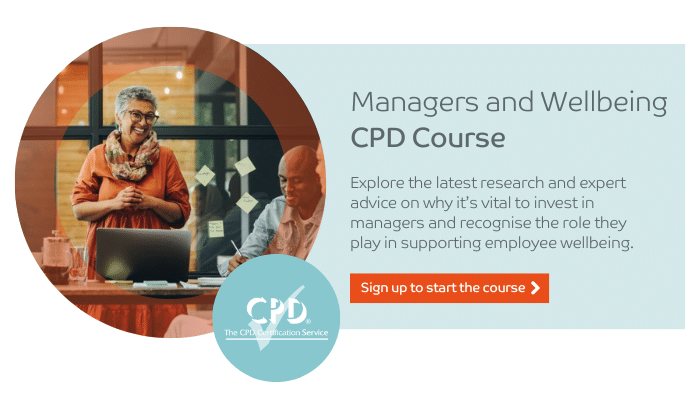A study by The Workforce Institute at UKG found that managers have a higher impact on mental health than doctors and therapists. With more employees actively looking for wellbeing support, the role of the manager is evolving beyond managing performance. The Westfield Health Workplace Wellbeing Survey found that the most important qualities for a manager, as rated by employees, are compassion, understanding and availability to talk.
Cathy Lawson, an experienced Mental Health First Aid Trainer, explores how businesses can provide their managers with the skills needed to develop positive relationships and initiate discussions about mental health.
Tips for the ‘wellbeing conversation’
Give reassurance
It’s important to recognise the difference between performance issues and wellbeing. The role of a manager includes being able to reassure employees that discussing a productivity shift is not about their performance and instead is about concern, showing support and empathy.
When opening this conversation, showing that the discussion is not a performance review, that their job is safe and that what is discussed will be a confidential conversation are all best practices for building manager-employee relationships.
Open up the conversation
Don’t be afraid to ask. It might feel like that asking will be intrusive or nosy, but managers can tie themselves up into knots about doing it wrong and making mistakes. This can result in managers avoiding mental health conversations all together. But avoiding these topics can stigmatise mental health, show a lack of mental health support and impact recovery. Three things that are helpful to practice are listening, reassuring and signposting.
Know where to signpost
It’s important to know what’s available within your organisation and externally to give the best guidance. The other challenge for managers is having the confidence to have the conversation and not to be afraid to talk about things like anxiety, depression and, in worst case, suicide and risk. To be able to effectively signpost, you have to know what is happening with your employees’ mental health.
Look for signs
There will be clues pointing to employee mental health worsening. The first step is thinking about changes in communication styles; are they being blunt or seeming disinterested? If you notice changes, then investigate their productivity and quality of work. If this is dipping, then it’s possible that there is a disruption with their mental health. Noticing any of these signs should be a cause for concern rather than any disciplinary action. By being aware of these changes, it can help open up these conversations and show empathy as a manager.
Role model the behaviours you want to see
Are you expecting one thing but doing something different yourself? Role modelling wellbeing behaviour is part of a good workplace culture – only working within designated hours, taking time off when you need to for both mental or physical health and being open about wellbeing.
Showing emotional vulnerability is a key skill that should be exercised. If you’re not willing to be vulnerable and share what’s going on for you, how can you expect the people around you to do the same? By showing this behaviour, you create an open, safe space for employees to do the same.
Try our free CPD-accredited Managers and Wellbeing course
If you’re looking for a more in-depth guide on the role of a manager and building connection in the workplace, our Managers and Wellbeing course covers the latest research, plus advice from our in-house experts to help you make the case for investing in manager and employee wellbeing. The course also helps to show the importance of building supportive relationships and demonstrate its value in your business.
